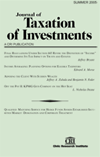Investors Retain Assets Rather Than Realizing Capital Gains on Dispositions: Should Tax Policy Counteract This “Lock-In Effect”?
Author: Devin Fargnoli.
Source: Volume 24, Number 04, Summer 2007 , pp.323-347(25)

< previous article |next article > |return to table of contents
Abstract:
In 2005, there were approximately $539 billion in capital gains realizations—the most ever excluding those of the year 2000. As U.S. stock markets continue to surge, with the Dow Jones Industrial Average setting all-time highs on multiple occasions in 2006, accrued capital gains from equities are increasing along with the amount of potential future realizations. While the accrual of additional gains is a boon for the average net worth of Americans, it fails to fully stimulate the economy or redistribute wealth, due to what is now commonly known as the “lock-in effect.” The lock-in effect is a term that generally refers to the reluctance investors have for selling capital assets with unrealized gains due to the capital gains taxation incurred upon realization. Because only selling is taxed and holding is not, shares of stocks effectively become locked in the portfolios of investors who have little incentive to sell while receiving an “interest-free loan from the Treasury in the amount of their tax payment simply by deferring realization.” This deferral advantage has led to funds becoming locked in their current investments.Keywords:
Affiliations:
.